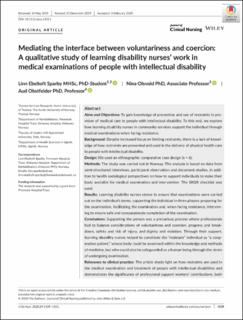| dc.contributor.author | Sparby, Linn Ebeltoft | |
| dc.contributor.author | Olsvold, Nina | |
| dc.contributor.author | Obstfelder, Aud | |
| dc.date.accessioned | 2021-01-14T12:06:08Z | |
| dc.date.available | 2021-01-14T12:06:08Z | |
| dc.date.created | 2020-02-20T10:23:41Z | |
| dc.date.issued | 2020 | |
| dc.identifier.citation | Journal of Clinical Nursing (JCN). 2020, 29 (9-10), 1539-1551. | en_US |
| dc.identifier.issn | 0962-1067 | |
| dc.identifier.uri | https://hdl.handle.net/11250/2723069 | |
| dc.description.abstract | Aims and Objectives
To gain knowledge of prevention and use of restraints in provision of medical care to people with intellectual disability. To this end, we explore how learning disability nurses in community services support the individual through medical examinations when facing resistance.
Background
Despite increased focus on limiting restraints, there is a lack of knowledge of how restraints are prevented and used in the delivery of physical health care to people with intellectual disability.
Design
We used an ethnographic comparative case design (n = 6).
Methods
The study was carried out in Norway. The analysis is based on data from semi‐structured interviews, participant observation and document studies, in addition to health sociological perspectives on how to support individuals to make their body available for medical examination and intervention. The SRQR checklist was used.
Results
Learning disability nurses strove to ensure that examinations were carried out on the individual's terms, supporting the individual in three phases: preparing for the examination, facilitating the examination and, when facing resistance, intervening to ensure safe and compassionate completion of the examination.
Conclusions
Supporting the person was a precarious process where professionals had to balance considerations of voluntariness and coercion, progress and breakdown, safety and risk of injury, and dignity and violation. Through their support, learning disability nurses helped to constitute the “resistant” individual as “a cooperative patient,” whose body could be examined within the knowledge and methods of medicine, but who could also be safeguarded as a human being through the strain of undergoing examination. | en_US |
| dc.language.iso | eng | en_US |
| dc.publisher | Wiley | en_US |
| dc.rights | Navngivelse 4.0 Internasjonal | * |
| dc.rights.uri | http://creativecommons.org/licenses/by/4.0/deed.no | * |
| dc.title | Mediating the interface between voluntariness and coercion: a qualitative study of learning disability nurses` work in medical examinations of people with intellectual disability | en_US |
| dc.type | Peer reviewed | en_US |
| dc.type | Journal article | en_US |
| dc.description.version | publishedVersion | en_US |
| dc.source.pagenumber | 1539-1551 | en_US |
| dc.source.volume | 29 | en_US |
| dc.source.journal | Journal of Clinical Nursing (JCN) | en_US |
| dc.source.issue | 9-10 | en_US |
| dc.identifier.doi | 10.1111/jocn.15211 | |
| dc.identifier.cristin | 1796005 | |
| dc.description.localcode | © 2020 The Authors. Journal of Clinical Nursing published by John Wiley & Sons Ltd This is an open access article under the terms of the Creative Commons Attribution License, which permits use, distribution and reproduction in any medium, provided the original work is properly cited. | en_US |
| cristin.ispublished | true | |
| cristin.fulltext | original | |
| cristin.qualitycode | 2 | |

